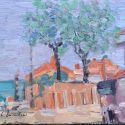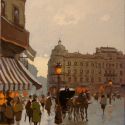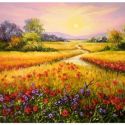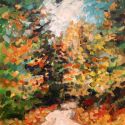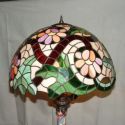The Metropolitan Museum of Art is presenting between November 21 2006 - May 20 2007 an exhibition dedicated to the works of Louis Comfort Tiffany, organised with the support of Tiffany & Co. Foundation. If the other Tiffany exhibitions so far have been dedicated solely to the works of the artist, this time the subject is his magnificent house in Oyster Bay, New York, named Laurelton Hall.
Tiffany finished constructing it in 1905 and the house turned out to be his definitive masterpiece, synthesizing his artistic personality. Step by step, from the first drafts to the interior and exterior decorations, Tiffany created every aspect of the house, even the most insignifiant ones, and the result was truly stunning. Laurelton Hall turned out to be not only the home of a great master, but also the refuge where Tiffany used to retreat, in order to escape the artistic and business life. It was also his personal museum, where he kept some of his most treasured work, as well as his colections of Japanese, Chinese and Native American art. Unfortunatelly this splendid example of arhitecture was destroyed in a devastating fire in 1957, only some of the works survived. These are being reunited in the exhibition at the MET, alongside some of the architectural elements and interior designs that have been recovered. It is the story of an artist, told by the memories of his home.
Louis Comfort Tiffany was not only one of the most important artists of the 19th - 20th century, but also a name which signified luxury and elegance. He was a fortunate artist, for his father was none other than Charles Lewis Tiffany, founder and main owner of Tiffany & Company, the famouse New York store, where one could find not only expensive and exquisite jewelry, but also other luxury merchandises. So it wasn't a surprise that Louis C. Tiffany knew what art and business were, how to put them together. Even more, his father fortune gave him the financial support for his own commercial and creative projects.
After completing the Eagleswood Military Academy in New Jersey, Tiffany, who already was passionate about art, decided to travel extensively and during this period he was also the student of some of the most important artists in the world. Strongly influenced by the style of George Inness, an American landscape artist who was also his teacher at Eagleswood, Tiffany proved to be a competent painter, with a keen sense for color. He will be interested in painting for the rest of his life, but he chose to dedicate himself to creating, producing and selling items of decorative art. It was a choice to be expected from the inheritor of Tiffany & Company.
Due to his artistic training and his business knowledge, Tiffany chose to approach a new field - interior decoration - motivated by the ascension of the Aesthetism in the 1870 - 1880s. He chose to begin a soon to be famous collaboration with three other artists : the painter and decorator Samuel Colman, the textile designer Candace Wheeler, the artist and furniture designer Lockwood de Forest. The four will later be known by the name Louis C. Tiffany & Associated Artists, a company that would write history. In a short period of time the four enthusiastic young artists managed to atract several important clients. Among those was the President Chester A. Arthur, who commisioned the interior decorations for some of the public rooms in the White House. It was the big break that Tiffany needed, and his popularity soon rised.
Still, Tiffany felt that he could do more, much more, and tried not only to obey the taste of his clients, but also to offer something new with every collection, such as the Oriental or naturalistic designs. He began experimenting with glass, a medium which atracted him. In the beginning he learned the tricks of working with glass by trying to reproduce the old medieval stained-glass models and the ancient techniques. Then he extended his approach, creating many different designs, in many colors and textures, and after a while his comprehensive catalogue had over 5000 colors and textures. His dream was to "paint with glass", and he managed to do that just fine, giving his interior design elements light and colors hard to imagine before.
These glass works managed to bring fame and fortune to Tiffany, beyond his wildest expectations. It was a good start for him, and in a few years he was already considered one of the most important artists of his time, and decades later was a legend. But he was also respected as a good businesman, who managed to bring together the interest for art and talent for transactions. In 1883 Tiffany decided to put an end to Associated Artists. He would eventually found several firms in New York, in order for him to sale his glass creations. At start his commisions were mainly religious and figurative compositions in stained-glass, made for various churches. For a rather long time Tiffany will concentrate on this type of commisions, later creating some luxury and elegant windows for offices, firms and wealthy collectors, decorated with landscapes or flowers. Even in Tiffany had always been the main creative mind behind his firms' works, he had several important and talented collaborators, such as Frederic E. Church, Will H. Low or Elihu Vedder. Those were some of the most important young artists of his time, and brought a refreshing change in Tiffany's style.
Towards the end of the 19th century Tiffany began working with Arthur J. Nash, at the time one of the most important and respected American glassmakers. The two, cooperating with a team of chemists, designers and artisans, managed to produce the iridescent blown glass, patented as Favrile. This new invention offered the company a chance to experiment and offer it's prospective customers new designs, textures and colors. The catalogue was greatly extended, and many more objects were created : vases, stemware, place settings, shades for candlesticks and oil lamps. Later, in order to take advantage of Edison's invention, the electrical lightbulb, Tiffany created several designs of leaded-glass lampshades, for which he used off-cuts of opalescent glass, the remains too small to be used for stained-glass.
His Corona factory, managed by Alvin Tuck, adapted even further to the market and started producing metal objects. If at first Tiffany only created some metal lamp bases for his shades, but as this proved really popular he launched several collections of glass and metal accessories : desk sets, clocks, candleholders. By the end of the century Tiffany was already considered to be a great artist, and the prices of his creations was constantly going up.
One of his most important and successful creations was his lampshades, which gained the nickname "glowing fantasies" from the French dealer Seigfried Bing, who also invented the term Art Nouveau. His lampshades proved to be an amazing commercial success, and by 1906 the catalogue contained over 125 different models, gaining several prestigious prizes and distinctions at World Fairs and exhibitions all over Europe and the US.
In the first decade of the 20th century Tiffany began being atracted to the more naturalist models, inspired by imediater reality. This change in his style was motivated both by his interest in horticulture and the influence of Art Nouveau, by then very much in fashion. In order to offer his clients an even larger catalogue he created several beautiful and intricate flower lampshades, which proved once again to be very popular. He designed these series together with a group of young artists, most of the females, such as Clara Driscoll, Mrs. Curtis Fueschel and Agnes Northrup.
Louis Comfort Tiffany was both a talented artist and a successful businessman. Besides his talent, he also enjoyed his father's financial support. Even if the two companies were separate, the would seldom work together, and Tiffany Studios products were sold at Tiffany & Company. Even if during the 20s Tiffany products were still present on the market, the production decreased and eventually stopped during the First Wolrd War, when the European markets closed and the tastes of the public changed. The famous designer died on January 17th 1933, but he already was a legend of his time. His original creations are nowadays very popular among collectors, and have often been the highlights of international art auctions.
October 2006



